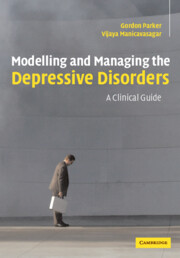Book contents
- Frontmatter
- Contents
- Acknowledgements
- Introduction
- Part I The current model for depressive disorders and its impact on clinical management
- Part II The diagnosis and management of melancholic and psychotic depression
- Part III An introduction to non-melancholic depression
- Part IV Modelling and managing the non-melancholic depressive disorders
- 13 Acute stress-related non-melancholic depression
- 14 Acute stress-related non-melancholic depression: ‘key and lock’ model
- 15 Chronic stress-related non-melancholic depression
- 16 The perfectionist personality style and non-melancholic depression
- 17 Irritability and non-melancholic depression
- 18 Anxious worrying and non-melancholic depression
- 19 Social avoidance and non-melancholic depression
- 20 Personal reserve and non-melancholic depression
- 21 Rejection sensitivity and non-melancholic depression
- 22 Self-focused personality style and non-melancholic depression
- 23 Self-criticism and non-melancholic depression
- 24 Natural and alternative treatments for non-melancholic depression
- Appendix 1 The DMI-18 and the DMI-10
- Appendix 2 The CORE system of measuring psychomotor disturbance
- Appendix 3 The temperament and personality measure
- References
- Index
14 - Acute stress-related non-melancholic depression: ‘key and lock’ model
from Part IV - Modelling and managing the non-melancholic depressive disorders
Published online by Cambridge University Press: 17 August 2009
- Frontmatter
- Contents
- Acknowledgements
- Introduction
- Part I The current model for depressive disorders and its impact on clinical management
- Part II The diagnosis and management of melancholic and psychotic depression
- Part III An introduction to non-melancholic depression
- Part IV Modelling and managing the non-melancholic depressive disorders
- 13 Acute stress-related non-melancholic depression
- 14 Acute stress-related non-melancholic depression: ‘key and lock’ model
- 15 Chronic stress-related non-melancholic depression
- 16 The perfectionist personality style and non-melancholic depression
- 17 Irritability and non-melancholic depression
- 18 Anxious worrying and non-melancholic depression
- 19 Social avoidance and non-melancholic depression
- 20 Personal reserve and non-melancholic depression
- 21 Rejection sensitivity and non-melancholic depression
- 22 Self-focused personality style and non-melancholic depression
- 23 Self-criticism and non-melancholic depression
- 24 Natural and alternative treatments for non-melancholic depression
- Appendix 1 The DMI-18 and the DMI-10
- Appendix 2 The CORE system of measuring psychomotor disturbance
- Appendix 3 The temperament and personality measure
- References
- Index
Summary
A second type of expression of acute stress-driven non-melancholic depression is characterised by an intense emotional reaction that appears disproportionate to the stressor (‘key and lock’ model) which we refer to as Type 2. This stressor has particular salience to the depressed individual, often unlocking histories of previous emotionally charged or traumatic events. Individuals with expressions of Type 2 acute stress-related non-melancholic depression may not be immediately aware of the reasons for their intense reaction. Once these reasons are uncovered, usually with the help of a therapist, understanding and accepting the links with their past can help to alleviate many of their distressing symptoms and build resilience against future reactions of this type.
The psychotransmitter model
Some life events have particular salience for the development of non-melancholic depression. Using an agonist model once again, some types of depressogenic neurotransmitters (life events) with salient types of psychological configurations can rapidly dock and lock onto receptors (interpretation and reaction) and initiate high levels of cellular activity (stress). In response to that activity, channels open and remain opened (here, perceptual and attributIONal styles reinforce the interpretation of and reactions to life events), and continue to stimulate cellular activity to dangerous levels. The post-synaptic neuron once again becomes over-stimulated and has to expend energy in order to slow down cellular activity by removing receptors and thus closing the attributION channels which, in turn, also shuts down self-esteem (causing depression).
- Type
- Chapter
- Information
- Modelling and Managing the Depressive DisordersA Clinical Guide, pp. 117 - 122Publisher: Cambridge University PressPrint publication year: 2005



